Telescope Overview
Unfolding the Universe
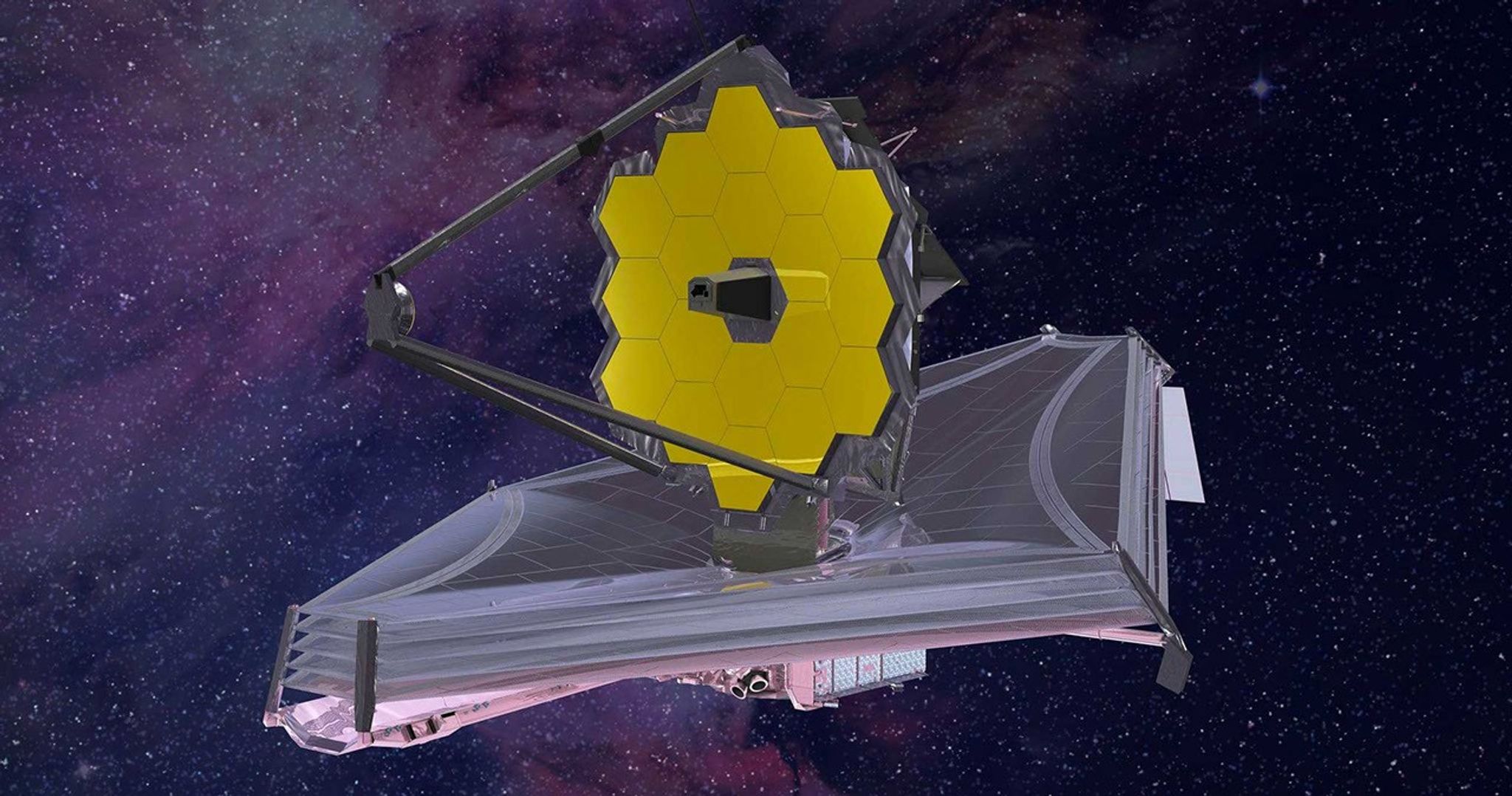
The James Webb Space Telescope is the largest, most complex observatory sent into space. Webb’s innovative design tackles the two main challenges for an infrared telescope: It needs a very large mirror to collect enough light, and it has to be kept cold to keep unwanted sources of infrared from interfering with the light being observed. Webb’s key components include an enormous primary mirror to collect infrared light, a supersized sunshield to keep the telescope cold, and four scientific instruments to conduct its ambitious science operations.
The size of the mirror and sunshield present another challenge: Webb must fit into the limited space within a launch vehicle. Scientists and engineers came up with a creative solution by turning Webb into a piece of enormous origami. The telescope is designed to neatly fold upon itself for launch, then complete a complicated series of steps to unfurl onits way to its observation post a million miles from Earth.
About the Webb Telescope
Webb's Size
The bigger the telescope, the better its vision…
Webb is the largest telescope NASA has ever sent into space. Webb is designed to be as light as possible, but still measure large enough to achieve its scientific goals.
Webb’s primary mirror towers more than two stories high and once unfurled, its protective sunshield measures about the size of a tennis court. On Earth, Webb tipped the scales at more than 13,000 pounds—just about equal to the weight of an adult African elephant.
For Webb to fit in the launch vehicle, an Ariane 5 rocket, it needed to fold origami-style to about a quarter of its full size, then unfolded on its way to space.
Webb was intricately folded up to fit inside the Ariane 5, which provided a cylindrical stowing space 16.19 meters long and 4.57 meters across (roughly 53 feet by 15 feet). There was little room to spare in the payload fairing.
Mirror Quick Facts:
- Total payload mass: about 6,200 kilograms (about 13,650 pounds on Earth)
- Height of entire observatory: 8 meters (28 feet)
- Size of sunshield: 21.2 meters by 14.2 meters (69.5 feet by 46.5 feet)
- Diameter of primary mirror: 6.6 meters (21.7 feet)
- Collecting area of primary mirror: 25.37 square meters (273.1 square feet)
- Mass of primary mirror: 705 kilograms (1,555 pounds on Earth)
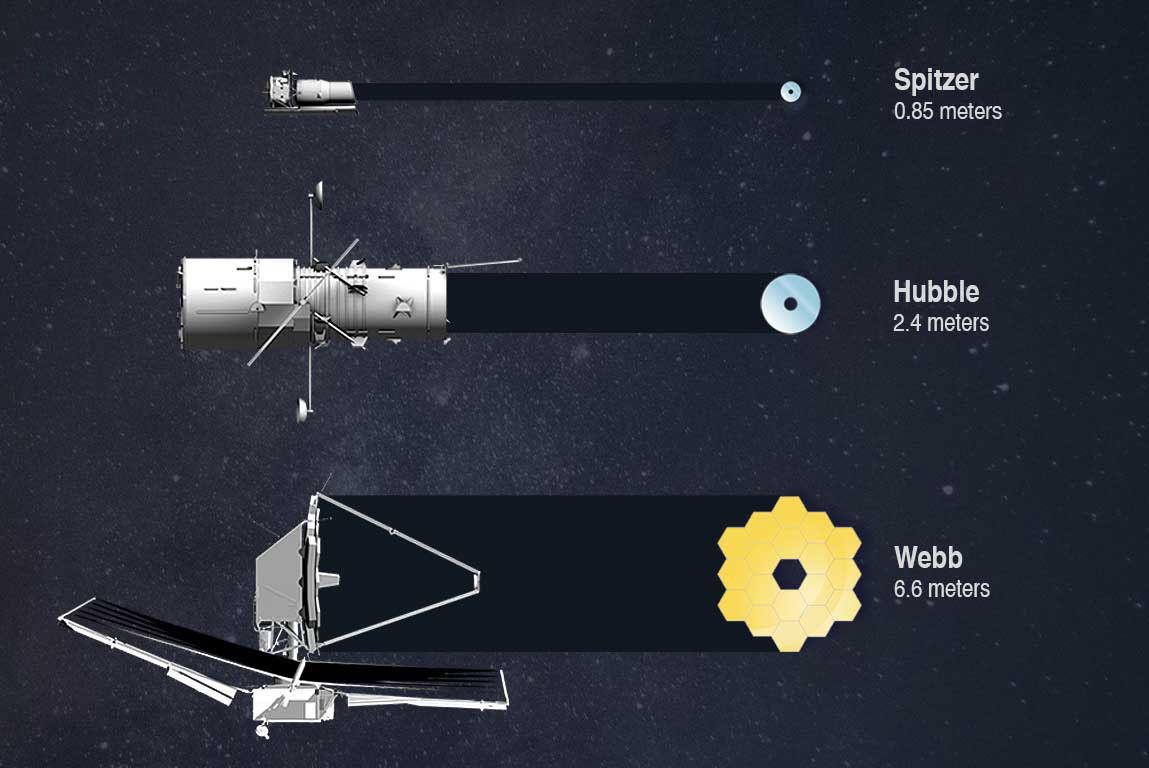
Webb's Mirrors
Webb’s extraordinary ability to capture high-resolution images and spectra from extremely dim or distant objects is a function of the size and construction of its primary mirror.
Primary Mirror Basics: Webb vs. Hubble
| Webb's Primary Mirror | Hubble's Primary Mirror | |
|---|---|---|
| Shape and Structure | Hexagonal, segmented (18 segments) | Circular, monolithic (single mirror) |
| Material | Beryllium coated with gold | Glass coated with aluminum and magnesium fluoride |
| Total Diameter | 6.6 m (21.7 ft) - 2.75 times Hubble | 2.4 m (7.8 ft) |
| Total Collecting Area | 25.37 m2 (273.1 ft2) - 5.6 times Hubble | 4.55 m2 (49 ft2) |
| Total Mirror Mass | 705 kg (1,555 pounds on Earth) | 825kg (1,825 pounds on Earth) |
| Segment Diameter | 1.32 m (4.3 ft) | N/A |
| Segment Area | 1.46 m2 (15.7 ft2) | N/A |
| Segment Mass | Mirror on its own: about 20 kg (45 lbs); Full assembly: about 40 kg (90 lbs) | N/A |
| Resolution | 0.03 arcsec at 0.6 µm | 0.05 arcsec at wavelengths near 0.5 µm |
| Wavelength Range | 0.6 – 28.8 µm (red to mid-infrared) | 0.115 – 2.5 µm (near-ultraviolet to near-infrared) |
Mirror Purpose and Size
The purpose of Webb’s 6.6-meter primary mirror is to collect infrared light traveling through space.
The main component of any visible or infrared telescope is the primary mirror. Webb’s primary mirror intercepts red and infrared light (0.6—28.8 microns) and reflects it onto a smaller secondary mirror, which then directs the light into the scientific instruments where it is recorded.
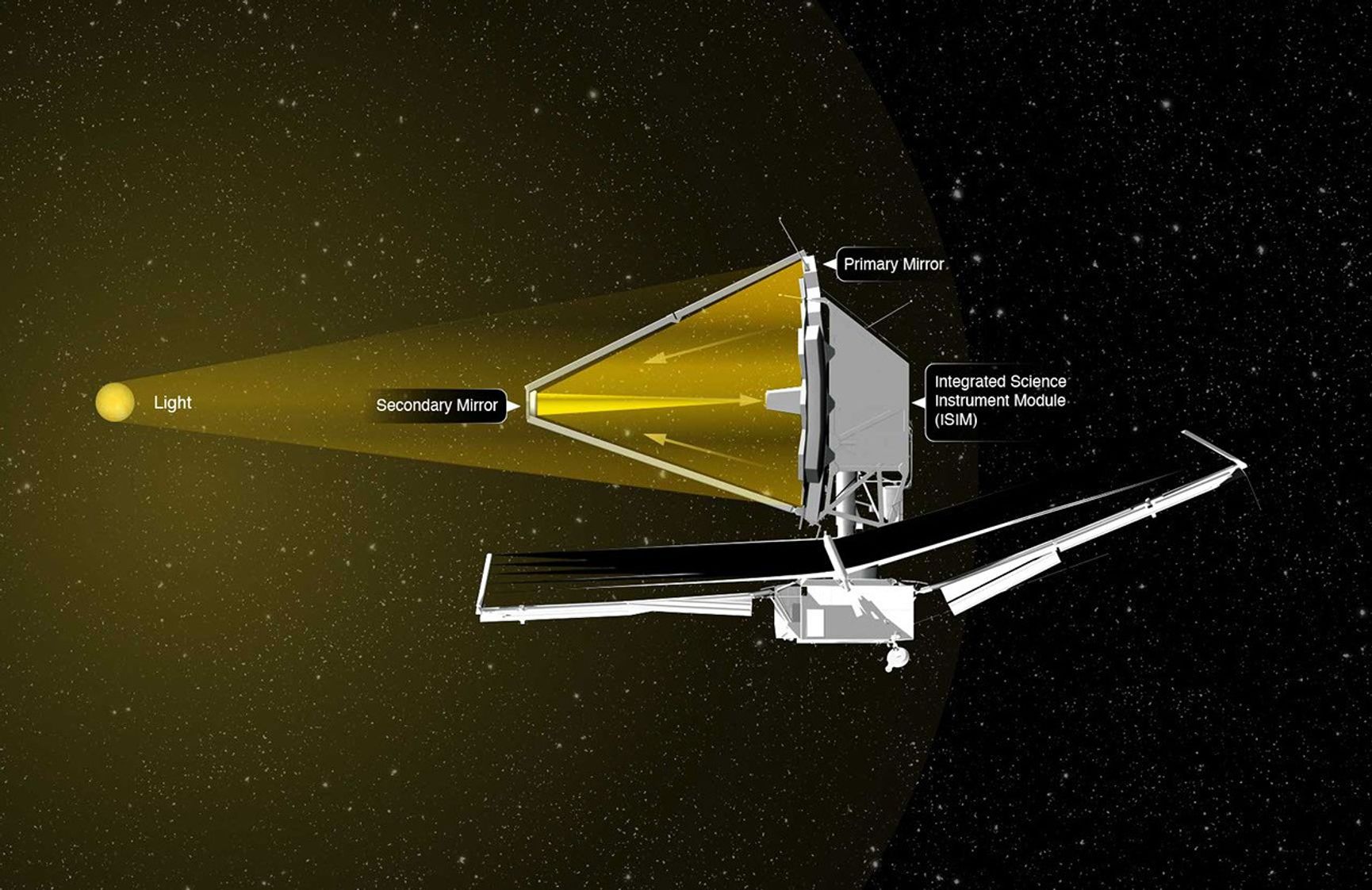
The primary mirror can be thought of as a “light bucket” whose power is a function of size in terms of collecting area (the total amount of area that reflects light onto the secondary mirror). The larger a mirror is, the more light it can collect over a given period of time. A larger mirror can therefore detect dimmer or more distant objects (i.e., it has higher sensitivity), and provide clearer, more detailed images and spectra (higher resolution) than a smaller mirror of the same construction.
With a diameter of 6.6 meters (21.7 feet) and a collecting area of 25 square meters (270 square feet), Webb’s mirror is large enough to detect the faint infrared light of galaxies more than 13.5 billion light-years away.
Did you know? Webb’s primary mirror is passive: It does not attract light or emit signals in order to “probe” space. It merely intercepts light that is already traveling through space.
Mirror Structure
Webb’s primary mirror consists of 18 separate, almost identical hexagonal segments, arranged in a larger hexagonal shape with one empty hexagon in the middle. Although each mirror segment is flat, when fully deployed and in operation, the full mirror is slightly concave. The orientation and precise shape (flatness) of each mirror segment can be adjusted independently in order to focus the light with sufficient precision onto the secondary mirror.
Segmentation makes it possible to fold the mirror small enough to fit inside the Ariane 5 launch vehicle and makes it possible to build a mirror with such high resolution.
Mirror Materials
Webb’s primary and secondary mirrors are composed of strong, light, and durable beryllium metal with a thin coating of gold to reflect infrared light.
Beryllium is used instead of glass because of its combination of strength, low density, and ability to withstand very low temperatures. Beryllium’s density is so low, in fact, that although Webb’s mirror is more than 5 times greater than Hubble’s mirror in area, it is lighter. Beryllium is also extremely rigid and has a low thermal expansion: It does not expand or contract significantly with changes in temperature, which allows the mirrors to maintain their shape across the wide range of temperatures experienced on Earth and in space.
Each mirror segment is coated in a thin layer of gold roughly 100 nanometers (0.000004 inches) thick, or roughly 1/1000 the thickness of a sheet of paper. Gold is used instead of aluminum or silver because it reflects red to mid-infrared light extremely well. (Light that is absorbed by the mirror cannot be reflected into the instruments and will not appear in images or spectra.) The total amount of gold on the mirrors is only about 50 grams (less than 2 ounces, or about the mass of a golf ball), which would fit into a sphere the size of a marble.
Comparisons:
Webb’s primary mirror has a height of 6.6 meters (21.7 feet), which is . . .
- 4.3 times taller than Lady Gaga (without heels)
- 3.2 times taller than LeBron James (also without heels)
- A little taller than a giraffe
- 6.6 Minecraft blocks high
Webb’s primary mirror has an area of about 25 m2 (270 ft2), which is . . .
- About 6 times larger than a ping pong table
- 1/10th the size of a tennis court
- 1/17th the size of a professional basketball court
- About the same size as a tiny studio apartment
Webb’s Wavelength Range, Sensitivity, and Resolution
Webb’s mirrors and instruments are designed to have the wavelength range, sensitivity, and resolution to detect extremely faint red to mid-infrared light to capture detailed images and spectra from objects as close as Mars to as distant as 13.5 billion light-years.
Wavelength range is a measure of the specific wavelengths of light (colors) that a telescope is designed to detect. Wavelength range determines the types of objects and materials it can detect and the questions that it can be used to answer. Webb’s mirrors and instruments are designed to collect and detect light ranging from 0.6—28.8 microns (600—28,800 nanometers), which includes visible red, near-infrared, and mid-infrared light.
Webb is so sensitive that it could detect the heat of a bumblebee as far away as the Moon.
Sensitivity is a measure of the faintest light that a telescope can detect. The larger the primary mirror, the more photons it can collect, and the higher the telescope’s sensitivity. More sensitive telescopes can therefore detect light from smaller, more distant, or more obscured objects.
Additional Resources
A more detailed look at Webb’s mirrors
Webb's Sunshield
To capture infrared light from faint and distant objects, Webb’s instruments must be protected from the bright visible and infrared light of the Sun, Earth, and Moon.
Webb’s tennis-court-sized sunshield is potentially its most distinctive feature. The sunshield will provide a cold and thermally stable environment for the telescope and its instruments.
How It Works
For the sunshield to work, Webb must be in an orbit where the Sun, Earth, and Moon remain in the same direction, away from the telescope on the far side of the sunshield. That orbit is known as the semi-stable Lagrange point L2 (see below). The kite-like shape of the sunshield also assists in directing heat out the sides around the perimeter.
Cross-Section of Webb's Five-Layer Sunshield
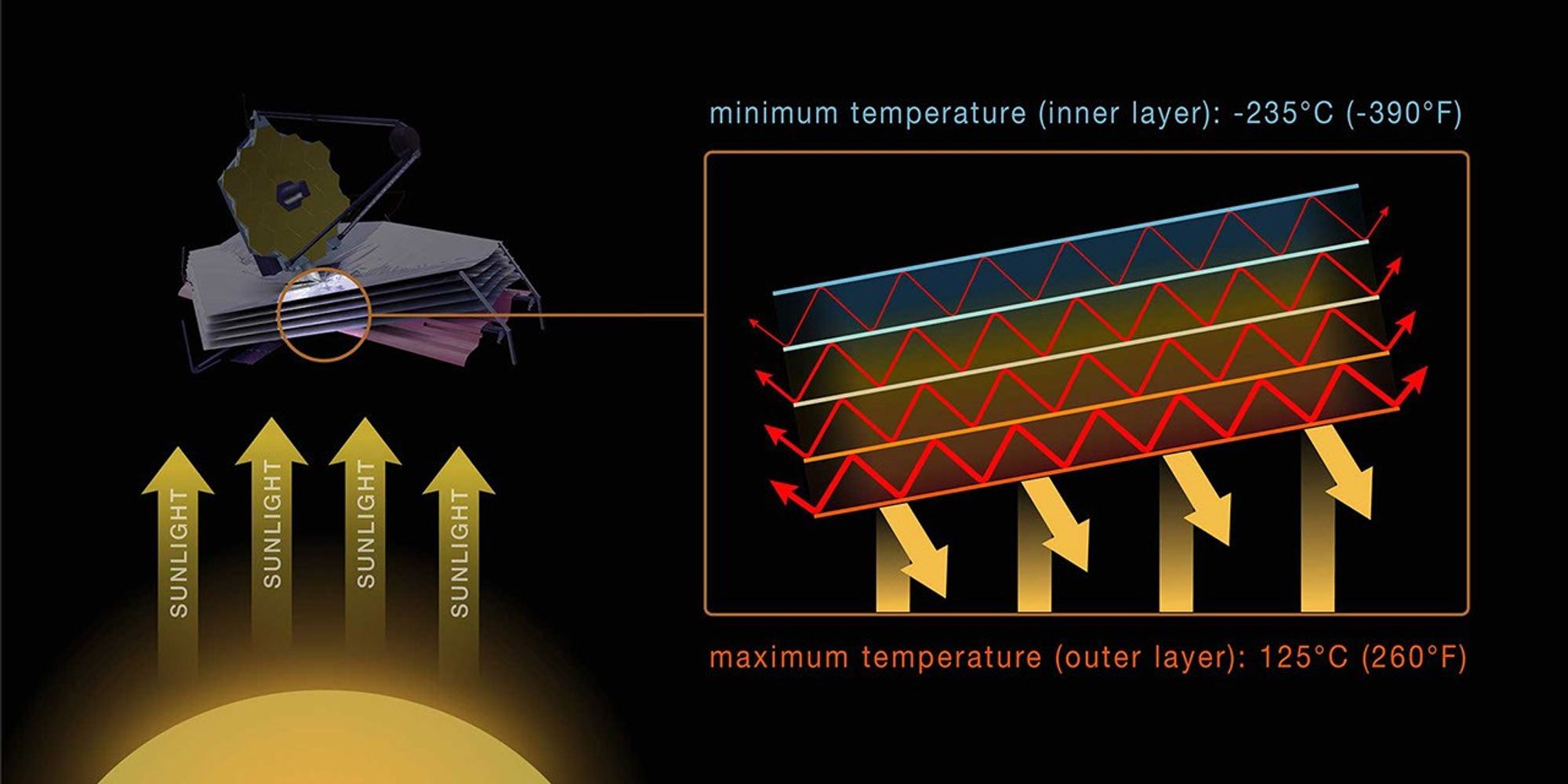
Thin, Light, Durable Layers
Kapton Layers: Webb’s sunshield consists of five layers of a heat-resistant, strong material called Kapton, which is coated in aluminum and silicon. Each layer has a specific thickness and size related to its position. All layers are less than a millimeter thick, similar to the thickness of a dime. The inner membrane Kapton core of each layer is as thin as a piece of human hair.
Separated Design: Collectively, all five layers will offer a safe and insulating source of shade for the telescope. The layers do not touch, reducing the transfer of heat from one layer to the next. The aluminum coatings also help cut down on warmth transmission.
Damage Control: Part of the sunshield’s strength comes from its supporting ribs, which give it stability without becoming brittle. The sunshield layers are also built with ripstops included, so if something pierces a layer, it can't rip very far, allowing the layer to maintain structural integrity. This is vital for the integrity of this sunshield because it allows for small holes to form—debris and micrometeorites are a constant concern of all space missions—without causing additional damage in other areas of the sunshield. The multilayer design also means that any one hole doesn’t compromise the effectiveness of the shield.
Deployment: Not long after launch, the sunshield slowly unfurled, stretched taut by cables attached to motors.
Sunshield Quick Facts
- Dimensions (unfolded): 21.2 m by 14.2 m (69.5 ft by 46.5 ft)
- Materials: five layers of Kapton coated with aluminum and doped silicon
- Sun-facing layer estimated maximum temperature: ~400 K (260°F, 125°C)
- Innermost layer estimated minimum temperature: ~40 K (-390°F, -235°C)
- Keeps science instruments and mirrors at a cool 40 K (roughly -390°F, -235°C)
- Will be folded and stowed for launch
Additional Resources
More about Webb’s sunshield
Webb's Orbit and View of Sky
Webb orbits the Sun from a location near the second Sun-Earth Lagrange point (L2), approximately 1½ million kilometers (1 million miles) from Earth.
Webb’s Orbit Around L2
A Sun-Earth Lagrange point is a region in space where the gravitational pull of the Sun and Earth combine such that small objects in that region have the same orbital period (length of year) as Earth.
Webb is not located directly at L2, but instead moves in a halo orbit around L2, roughly perpendicular to its orbit around the Sun. Webb orbits L2 at a distance of roughly 500,000 kilometers (300,000 miles), completing one halo orbit every 168 days. To maintain its halo orbit around L2, Webb will need to reposition itself periodically using its thrusters.
Orbit Quick Facts
- Type of Orbit: Heliocentric
- Location: Sun-Earth Lagrange point 2
- Distance from Earth: About 1.5 million kilometers (1 million miles)
- Orbital Period: 168 days to orbit L2; 365 days to orbit the Sun
- Percentage of the sky visible at any given time of year: 39%
Advantages of L2
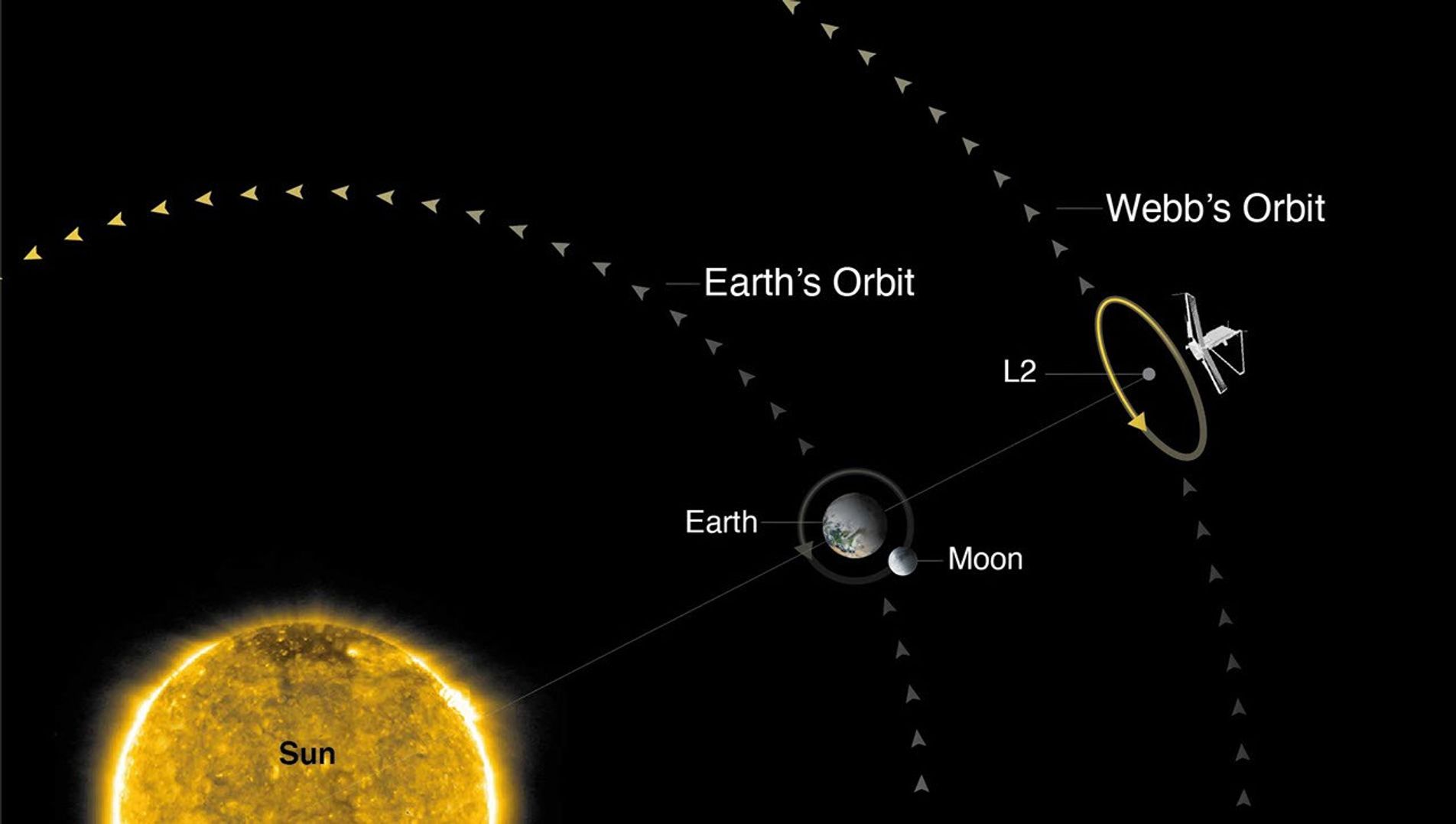
Webb’s observation post near L2 gives it a clear view of the sky with continuous communication with Earth, far from sources of bright light and heat that impede instrument function.
At L2, Webb is far beyond Earth’s atmosphere, which absorbs (blocks) most infrared light from celestial objects, and is far enough from the Sun, Earth, and Moon for the sunshield to be effective. Because L2 moves with Earth as Earth orbits the Sun, Webb’s relative position with respect to Earth does not change significantly over the course of the year. This simplifies communication between Earth and Webb and makes it possible for Webb’s sunshield to block the Sun, Earth, and Moon at all times. Webb’s halo orbit around L2 keeps it out of the shadows of Earth and the Moon, reducing temperature fluctuations and allowing it to maintain solar power.
The primary disadvantage of L2 is its distance. Unlike Hubble, which was repaired and upgraded five times, Webb is too far from Earth for a servicing mission.
Webb’s Field of Regard
Webb’s field of regard—the region of sky that the telescope can observe safely at a given time—changes over time as it orbits L2 and the Sun.
Field of regard is different from field of view, which is the area of sky that a particular instrument can observe at one time. The field of regard of a person standing on the ground is the sky above the horizon that is not blocked by the Moon, buildings, or other obstructions. The field of view of that person’s camera is the area of sky that fits into the frame.
About 39% of the sky is potentially visible to Webb at any given time. Over the course of 6 months, Webb has a view of almost the entire sky (i.e., the ability to point in almost every direction). Two small regions of the sky known as Continuous Viewing Zones (CVZs) can be observed at any time.
Because Webb must face away from objects that are warm enough and close enough to interfere with its ability to observe faint infrared light, it cannot observe the Sun, Mercury, Venus, Earth, or the Moon. (It can observe the parts of the Solar System that are beyond its orbit, including Mars, the asteroid belt, the outer planets, and the Kuiper Belt.)
Detailed knowledge of Webb’s field of regard is important for scheduling observations.
Did you know? Although there are a number of telescopes positioned near L2, including ESA’s Herschel and Planck space observatories and NASA’s future Nancy Grace Roman Space Telescope, the region is large and Webb is not in danger of colliding with any of them. Webb’s orbit around L2 is similar in scale to the Moon’s orbit around Earth.
Additional Resources
More about Webb’s orbit
Technical information about Webb’s orbit
Technical information about Webb’s Field of Regard
Webb's Other Key Components
While Webb’s iconic primary mirror and massive sunshield are its most recognizable features, the observatory has many other key components that ensure smooth operations and a successful mission.
Hot, Sun-Facing Side
Spacecraft Bus: This is Webb’s infrastructure. It provides the necessary support functions to operate the observatory. The Webb spacecraft bus provides electrical power, communications, attitude control, thermal control, health and safety functions, command and data handling, and communications services. The spacecraft bus operates at a temperature of about 300 kelvins (about 80 degrees Fahrenheit or 25 degrees Celsius).
Star Trackers: These are small telescopes that use star patterns to aim the observatory for coarse pointing of the telescope. The star tracker data enables the alignment and control system to point the telescope so that the target appears in the field of view of the intended instrument. Once an observation begins, the Fine Guidance Sensors (located in the Integrated Science Instrument Module with the instruments) can compensate for small drifts in the observatory's alignment and help the telescope maintain accurate pointing.
Solar Array: These panels covert sunlight into electricity to power Webb. The “powerhouse” of the telescope, the array will supply energy to all of the telescope’s scientific instruments and communication and propulsion subsystems. The solar array provides 2,000 watts of electrical power for the life of the mission, and there is enough propellant onboard for at least five years of science operations.
High-Gain Antenna: This is used to receive commands from Earth and transmit Webb’s science data , including imagery, to Earth. As such, the high gain antenna pointing must be periodically adjusted to keep Earth centered. The antenna repointing maneuvers are expected to result in a small but measurable pointing disturbance, so they are planned not to occur during science observations.
Trim Flap (Momentum Trim Tab): This piece helps stabilize the satellite. It balances the pressure put on Webb’s sunshield by sunlight. It can’t be adjusted in orbit.
Cold, Observing Side
Integrated Science Instrument Module, or ISIM: Houses all of Webb’s cameras, four science instruments, and the subsystems needed to operate them. It’s referred to as the heart of the telescope, and is what engineers call the main payload.
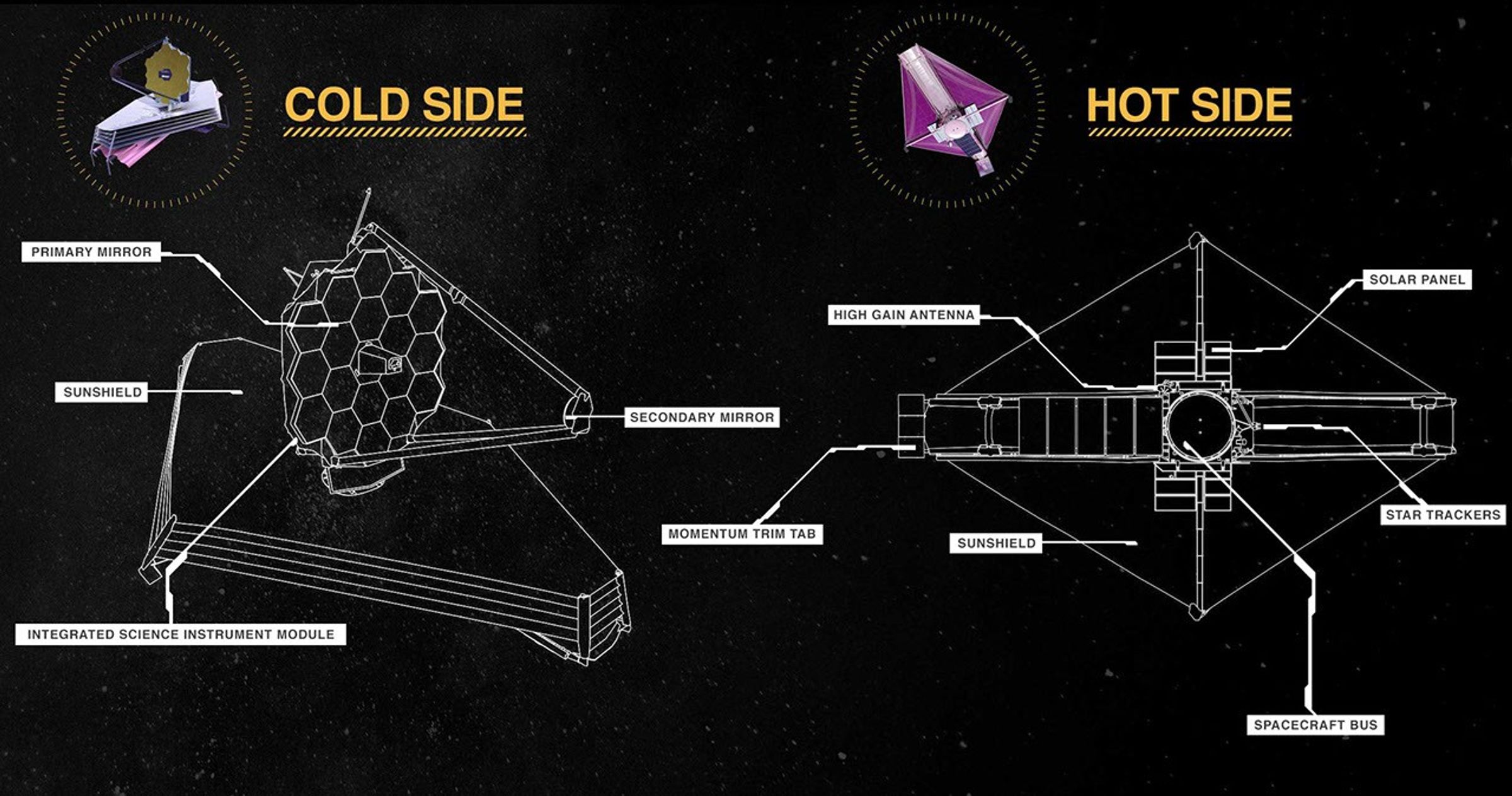
Additional Resources
More about Webb’s Spacecraft Bus
More about Webb’s ISIM
The values reflected in this guide are up to date and accurate as of pre-launch. Any varying values previously reported or reported on external websites were either estimated during early development of the telescope or misconstrued due to rounding or conversion errors.
Photo Gallery
Story Of Webb's Build
A curated gallery of over a decade of images of Webb's design, build, test and integration leading to it's launch on December 25, 2021.
The image below is a SLIDESHOW. Hover over the image to see the image title and controls. Click the image to go to a detail page with more info and the ability to download the image at various resolutions (click downward arrow in lower right corner).
View Slideshow as Thumbnail Gallery (new tab)



























